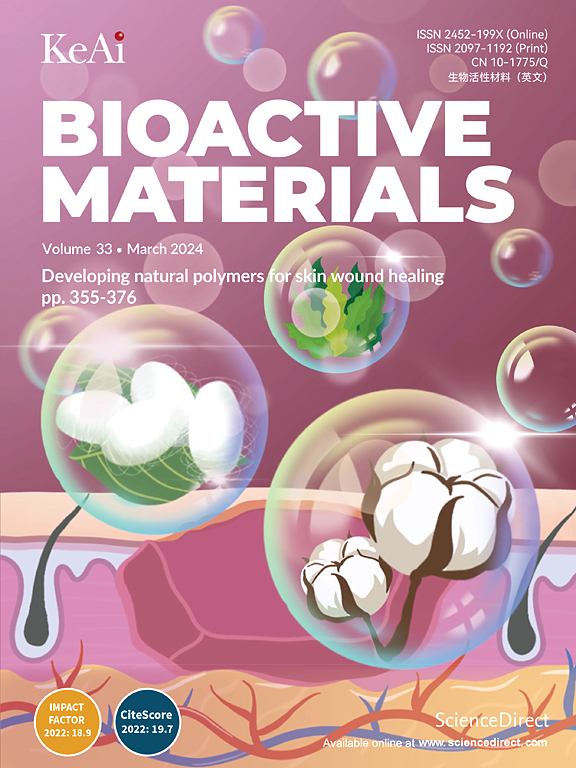Immune-modulated adhesive hydrogel for enhancing osteochondral graft adhesion and cartilage repair
IF 18
1区 医学
Q1 ENGINEERING, BIOMEDICAL
引用次数: 0
Abstract
Osteochondral autograft transfer system (OATS) can effectively improve cartilage injuries by obtaining bone-cartilage grafts from healthy sites and implanting them into the defective areas. However, in up to 40 % of patients, the lack of a stable adhesive interface between the osteochondral graft and the normal tissue surface reduces the repair efficiency. In this work, we report an injectable and biocompatible poly (N-hydroxyethyl acrylamide-N-hydroxy succinimide)/Gelatin (PHE-Gel) hydrogel, featuring the instant formation of a tough bio-interface, which allows for robust adhesion with osteochondral grafts. Through physicochemical characterization, we found that a system composed of 10%PHE-Gel possesses superior interfacial toughness and excellent biocompatibility. In vitro, mechanistic studies and RNA-seq analysis had shown that 10%PHE-Gel promotes the expression of cartilage anabolic metabolism genes by upregulating the hypoxia-inducible factor alpha (HIF-α) signaling pathway and downregulating the tumor necrosis factor (TNF) signaling pathway. Dimethyloxalylglycine (DMOG) loaded liposome (DMOG-Lip) promotes the transition of M1 macrophages to M2 macrophages, shifting the microenvironment towards a pro-repair direction. Studies on a rabbit OATS model indicated that DMOG-Lip loaded 10%PHE-Gel (10%PHE-Gel@DMOG-Lip) effectively modulated the immune microenvironment, facilitated the repair of the hyaline cartilage, and inhibited further degeneration of cartilage. This composite hydrogel offers a promising solution for enhancing OATS repair in tissue engineering and has the potential to improve outcomes in cartilage restoration procedures.

增强骨软骨移植物黏附和软骨修复的免疫调节黏附水凝胶
自体骨软骨移植系统(Osteochondral autograft transfer system, OATS)是一种从健康部位获得骨软骨移植物,并将其植入缺损部位的方法,可以有效改善软骨损伤。然而,在高达40%的患者中,骨软骨移植物与正常组织表面之间缺乏稳定的粘附界面降低了修复效率。在这项工作中,我们报告了一种可注射的生物相容性聚(n -羟乙基丙烯酰胺- n -羟基琥珀酰亚胺)/明胶(ph - gel)水凝胶,具有立即形成坚韧的生物界面的特点,允许与骨软骨移植物强大的粘附。通过理化表征,我们发现10%PHE-Gel组成的体系具有优异的界面韧性和良好的生物相容性。体外机制研究和RNA-seq分析表明,10%PHE-Gel通过上调缺氧诱导因子α (HIF-α)信号通路和下调肿瘤坏死因子(TNF)信号通路促进软骨合成代谢基因的表达。二甲基氧基酰甘氨酸(DMOG)负载脂质体(DMOG- lip)促进M1巨噬细胞向M2巨噬细胞转变,使微环境向促修复方向转变。兔燕麦模型研究表明,DMOG-Lip加载10% phe - gel (10%PHE-Gel@DMOG-Lip)可有效调节免疫微环境,促进透明软骨修复,抑制软骨进一步退变。这种复合水凝胶为增强组织工程中的OATS修复提供了一种有前途的解决方案,并有可能改善软骨修复过程的结果。
本文章由计算机程序翻译,如有差异,请以英文原文为准。
求助全文
约1分钟内获得全文
求助全文
来源期刊

Bioactive Materials
Biochemistry, Genetics and Molecular Biology-Biotechnology
CiteScore
28.00
自引率
6.30%
发文量
436
审稿时长
20 days
期刊介绍:
Bioactive Materials is a peer-reviewed research publication that focuses on advancements in bioactive materials. The journal accepts research papers, reviews, and rapid communications in the field of next-generation biomaterials that interact with cells, tissues, and organs in various living organisms.
The primary goal of Bioactive Materials is to promote the science and engineering of biomaterials that exhibit adaptiveness to the biological environment. These materials are specifically designed to stimulate or direct appropriate cell and tissue responses or regulate interactions with microorganisms.
The journal covers a wide range of bioactive materials, including those that are engineered or designed in terms of their physical form (e.g. particulate, fiber), topology (e.g. porosity, surface roughness), or dimensions (ranging from macro to nano-scales). Contributions are sought from the following categories of bioactive materials:
Bioactive metals and alloys
Bioactive inorganics: ceramics, glasses, and carbon-based materials
Bioactive polymers and gels
Bioactive materials derived from natural sources
Bioactive composites
These materials find applications in human and veterinary medicine, such as implants, tissue engineering scaffolds, cell/drug/gene carriers, as well as imaging and sensing devices.
 求助内容:
求助内容: 应助结果提醒方式:
应助结果提醒方式:


